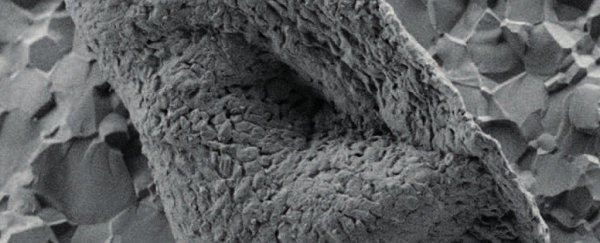A chemical analysis of fossils from 3.4 billion years ago has put them firmly in the running for the title of "world's oldest evidence of life."
Only discovered in 2011, the microfossils hail from the Strelley Pools formation in the Western Australian desert - an extraordinary find, considering Earth is thought to be around 4.5 billion years old.
Traces in these fossils appeared to be from ancient bacteria, but 3.4 billion years is an extraordinarily long time. Many fossils degrade, and sometimes it's hard to tell the difference between a fossil and a natural rock formation - particularly with older structures.
This is why an international team of researchers have taken to the microfossils with chemical analysis tools to try and learn more.
Using techniques such as Raman microspectroscopy, synchrotron-based X-ray absorption spectroscopy, focused ion beam, and scanning and transmission electron microscopy, they analysed the chemical spectra of the fossils in minute detail.
This array of high-tech approaches helped the researchers find film-like organic microfossils in freshly fractured rock samples.
The next step was to compare these results with more recent fossils - 1.9 billion-year-old microfossils from the Gunflint Formation in Canada.
On top of that, they also compared the results to modern bacteria. Interestingly, the Strelley microfossils were in a better state of preservation than the more recent Gunflint fossils, which could have been due to the impermeable rocks in which the former were embedded.
More importantly, though, once degradation had been taken into account, all three samples showed similar absorption features. This means the chemical residues were all created by similar building blocks, giving support to the idea that the Strelley fossils are evidence of life.
"We demonstrate that the elemental and molecular characteristics of these 3.4 Ga microfossils are consistent with biological remains, slightly degraded by fossilisation processes," said researcher Julien Alleon, a biogeochemist at MIT.
"This effectively supports the biological origin of the Strelley Pool microfossils."
He noted that it's remarkable how well the fossils have been preserved. Based on their molecular structure, the fossils have been exposed to temperatures of up to 300 degrees Celsius (572 degrees Fahrenheit) for long periods at a time
"And yet we are still able to see signs of their original chemistry," he said. "This is a step forward to confirming that these are indeed the oldest fossils yet discovered."
There are other contenders in the running. Stromatolites found in Isua in Greenland have been reported to contain "carbonaceous compounds, with isotopic ratios that are compatible with a biogenic origin". Those fossils are 3.7 billion years old.
Even more jaw-droppingly, a zircon sample from Canada has shown traces of biogenic carbon - from 4.1 billion years ago.
Meanwhile, other fossils found in the Strelley Pool Formation are around 3.4 billion years old. They also show chemical evidence of life.
"This is exciting work with the new types of analyses providing compelling evidence that the cherts contain biogenic microfossils," said researcher Vickie Bennett, a geochemist from the Australian National University.
"This is in line with other observations for early life from the Strelley Pool rocks, including stromatolites interpreted as microbial mats, and further confirming that the minimum age for life on Earth is 3.4 billion years.
The research has been published in the journal Geochemical Perspectives Letters.
